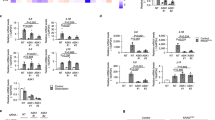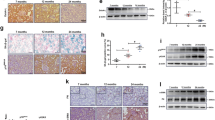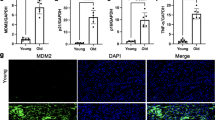Abstract
Recent studies on senescence marker protein-30 (SMP30) have shown that it has an important functional role in the aging process, but its precise participation in cellular works has not been fully determined. We hypothesize that SMP30 plays crucial roles in signaling processes by modulating the balance of protein tyrosine kinase (PTK)/protein tyrosine phosphatase (PTP) and in activating proinflammatory NF-κB. An experimental paradigm of gain and loss of SMP30 function was established using SMP30-overexpressed YPEN-1 cells (herein referred to as “SMP30(+) cells”) and SMP30Y/− knockout mouse kidneys. The resulting data show that SMP30 expression suppressed oxidative stress-induced PTK/PTP dysregulation and PP1/2A inactivation in SMP30(+) cells, leading to the suppression of NF-κB activation. In the kidneys of SMP30Y/− mice, SMP30 deficiency was found to induce NF-κB activation via the upstream signaling of NIK/IKK and MAPKs and to upregulate downstream NF-κB-responsive gene expression. In this study, we also demonstrate for the first time that SMP30 deficiency induced PTK activity in SMP30Y/− kidneys, thereby significantly increasing the tyrosine phosphorylation of a catalytic subunit of PP2A (PP2Ac-Tyr307). Based on these findings, we propose that SMP30 involves NF-κB regulation through the PTK/PTP balance and that the age-related decrease of SMP30 causes NF-κB activation, which contributes to an exacerbation of the inflammatory process during aging.
Key messages
-
SMP30-deficient mice induced a shorter lifespan and redox changes.
-
Overexpression of SMP30 prevented oxidative stress insults.
-
The depletion of SMP30 increased redox-related PTK/PTP imbalance and PP1/PP2A inactivation.
-
The depletion of SMP30 caused an elevation of NF-κB-responsive inflammatory markers.
-
SMP30 may be a potent inhibitory protein against oxidative stress and chronic inflammation.








Similar content being viewed by others
References
Fujita T, Shirasawa T, Uchida K, Maruyama N (1992) Isolation of cDNA clone encoding rat senescence marker protein-30 (SMP30) and its tissue distribution. Biochim Biophys Acta 1132:297–305
Fujita T, Uchida K, Maruyama N (1992) Purification of senescence marker protein-30 (SMP30) and its androgen-independent decrease with age in the rat liver. Biochim Biophys Acta 1116:122–128
Nakajima Y, Natori S (2000) Identification and characterization of an anterior fat body protein in an insect. J Biochem 127:901–908
Fujita T, Mandel JL, Shirasawa T, Hino O, Shirai T, Maruyama N (1995) Isolation of cDNA clone encoding human homologue of senescence marker protein-30 (SMP30) and its location on the X chromosome. Biochim Biophys Acta 1263:249–252
Fujita T, Inoue H, Kitamura T, Sato N, Shimosawa T, Maruyama N (1998) Senescence marker protein-30 (SMP30) rescues cell death by enhancing plasma membrane Ca(2+)-pum** activity in Hep G2 cells. Biochem Biophys Res Commun 250:374–380
Ando-Akatsuka Y, Yonemura S, Itoh M, Furuse M, Tsukita S (1999) Differential behavior of E-cadherin and occludin in their colocalization with ZO-1 during the establishment of epithelial cell polarity. J Cell Physiol 179:115–125
Kondo Y, Ishigami A, Kubo S, Handa S, Gomi K, Hirokawa K, Kajiyama N, Chiba T, Shimokado K, Maruyama N (2004) Senescence marker protein-30 is a unique enzyme that hydrolyzes diisopropyl phosphorofluoridate in the liver. FEBS Lett 570:57–62
Kondo Y, Inai Y, Sato Y, Handa S, Kubo S, Shimokado K, Goto S, Nishikimi M, Maruyama N, Ishigami A (2006) Senescence marker protein 30 functions as gluconolactonase in l-ascorbic acid biosynthesis, and its knockout mice are prone to scurvy. Proc Natl Acad Sci U S A 103:5723–5728
Mori T, Ishigami A, Seyama K, Onai R, Kubo S, Shimizu K, Maruyama N, Fukuchi Y (2004) Senescence marker protein-30 knockout mouse as a novel murine model of senile lung. Pathol Int 54:167–173
Sato T, Seyama K, Sato Y, Mori H, Souma S, Akiyoshi T, Kodama Y, Mori T, Goto S, Takahashi K et al (2006) Senescence marker protein-30 protects mice lungs from oxidative stress, aging, and smoking. Am J Respir Crit Care Med 174:530–537
Ishigami A, Kondo Y, Nanba R, Ohsawa T, Handa S, Kubo S, Akita M, Maruyama N (2004) SMP30 deficiency in mice causes an accumulation of neutral lipids and phospholipids in the liver and shortens the life span. Biochem Biophys Res Commun 315:575–580
Kondo Y, Hasegawa G, Okada H, Senmaru T, Fukui M, Nakamura N, Sawada M, Kitawaki J, Okanoue T, Kishimoto Y et al (2013) Lepr(db/db) Mice with senescence marker protein-30 knockout (Lepr(db/db)Smp30(Y/-)) exhibit increases in small dense-LDL and severe fatty liver despite being fed a standard diet. PLoS One 8:e65698
Ishikawa Y, Hashizume K, Kishimoto S, Tezuka Y, Nishigori H, Yamamoto N, Kondo Y, Maruyama N, Ishigami A, Kurosaka D (2012) Effect of vitamin C depletion on UVR-B induced cataract in SMP30/GNL knockout mice. Exp Eye Res 94:85–89
Senmaru T, Yamazaki M, Okada H, Asano M, Fukui M, Nakamura N, Obayashi H, Kondo Y, Maruyama N, Ishigami A et al (2012) Pancreatic insulin release in vitamin C-deficient senescence marker protein-30/gluconolactonase knockout mice. J Clin Biochem Nutr 50:114–118
Yu BP, Chung HY (2001) Stress resistance by caloric restriction for longevity. Ann N Y Acad Sci 928:39–47
Torres C, Francis MK, Lorenzini A, Tresini M, Cristofalo VJ (2003) Metabolic stabilization of MAP kinase phosphatase-2 in senescence of human fibroblasts. Exp Cell Res 290:195–206
Chiarugi P, Cirri P (2003) Redox regulation of protein tyrosine phosphatases during receptor tyrosine kinase signal transduction. Trends Biochem Sci 28:509–514
Chiarugi P (2005) PTPs versus PTKs: the redox side of the coin. Free Radic Res 39:353–364
Jung KJ, Lee EK, Yu BP, Chung HY (2009) Significance of protein tyrosine kinase/protein tyrosine phosphatase balance in the regulation of NF-kappaB signaling in the inflammatory process and aging. Free Radic Biol Med 47:983–991
Witt J, Barisic S, Schumann E, Allgower F, Sawodny O, Sauter T, Kulms D (2009) Mechanism of PP2A-mediated IKK beta dephosphorylation: a systems biological approach. BMC Syst Biol 3:71
Jung KJ, Kim DH, Lee EK, Song CW, Yu BP, Chung HY (2013) Oxidative stress induces inactivation of protein phosphatase 2A, promoting proinflammatory NF-kappaB in aged rat kidney. Free Radic Biol Med 61C:206–217
Sun W, Wang H, Zhao X, Yu Y, Fan Y, Wang X, Lu X, Zhang G, Fu S, Yang J (2010) Protein phosphatase 2A acts as a mitogen-activated protein kinase kinase kinase 3 (MEKK3) phosphatase to inhibit lysophosphatidic acid-induced IkappaB kinase beta/nuclear factor-kappaB activation. J Biol Chem 285:21341–21348
Chung HY, Sung B, Jung KJ, Zou Y, Yu BP (2006) The molecular inflammatory process in aging. Antioxid Redox Signal 8:572–581
Chung HY, Cesari M, Anton S, Marzetti E, Giovannini S, Seo AY, Carter C, Yu BP, Leeuwenburgh C (2009) Molecular inflammation: underpinnings of aging and age-related diseases. Ageing Res Rev 8:18–30
Jung KJ, Ishigami A, Maruyama N, Takahashi R, Goto S, Yu BP, Chung HY (2004) Modulation of gene expression of SMP-30 by LPS and calorie restriction during aging process. Exp Gerontol 39:1169–1177
Jung KJ, Maruyama N, Ishigami A, Yu BP, Chung HY (2006) The redox-sensitive DNA binding sites responsible for age-related downregulation of SMP30 by ERK pathway and reversal by calorie restriction. Antioxid Redox Signal 8:671–680
Son TG, Park HR, Kim SJ, Kim K, Kim MS, Ishigami A, Handa S, Maruyama N, Chung HY, Lee J (2009) Senescence marker protein 30 is up-regulated in kainate-induced hippocampal damage through ERK-mediated astrocytosis. J Neurosci Res 87:2890–2897
Ishigami A, Fujita T, Handa S, Shirasawa T, Koseki H, Kitamura T, Enomoto N, Sato N, Shimosawa T, Maruyama N (2002) Senescence marker protein-30 knockout mouse liver is highly susceptible to tumor necrosis factor-alpha- and Fas-mediated apoptosis. Am J Pathol 161:1273–1281
Kim HJ, Yu BP, Chung HY (2002) Molecular exploration of age-related NF-kappaB/IKK downregulation by calorie restriction in rat kidney. Free Radic Biol Med 32:991–1005
Song JH, Simons C, Cao L, Shin SH, Hong M, Chung IM (2003) Rapid uptake of oxidized ascorbate induces loss of cellular glutathione and oxidative stress in liver slices. Exp Mol Med 35:67–75
Jung KJ, Go EK, Kim JY, Yu BP, Chung HY (2009) Suppression of age-related renal changes in NF-kappaB and its target gene expression by dietary ferulate. J Nutr Biochem 20:378–388
Chung SW, Kim JM, Kim DH, Kim JY, Lee EK, Anton S, Jeong KS, Lee J, Yoo MA, Kim YJ et al (2010) Molecular delineation of gamma-ray-induced NF-kappaB activation and pro-inflammatory genes in SMP30 knockout mice. Radiat Res 173:629–634
Jiang ZX, Zhang ZY (2008) Targeting PTPs with small molecule inhibitors in cancer treatment. Cancer Metastasis Rev 27:263–272
Sattler M, Griffin JD (2003) Molecular mechanisms of transformation by the BCR-ABL oncogene. Semin Hematol 40:4–10
Chong ZZ, Maiese K (2007) The Src homology 2 domain tyrosine phosphatases SHP-1 and SHP-2: diversified control of cell growth, inflammation, and injury. Histol Histopathol 22:1251–1267
Zambuzzi WF, Milani R, Teti A (2010) Expanding the role of Src and protein-tyrosine phosphatases balance in modulating osteoblast metabolism: lessons from mice. Biochimie 92:327–332
Parri M, Chiarugi P (2013) Redox molecular machines involved in tumor progression. Antioxid Redox Signal 19:1828–1845
Li S, Wang L, Berman MA, Zhang Y, Dorf ME (2006) RNAi screen in mouse astrocytes identifies phosphatases that regulate NF-kappaB signaling. Mol Cell 24:497–509
Millward TA, Zolnierowicz S, Hemmings BA (1999) Regulation of protein kinase cascades by protein phosphatase 2A. Trends Biochem Sci 24:186–191
Csiszar A, Toth J, Peti-Peterdi J, Ungvari Z (2007) The aging kidney: role of endothelial oxidative stress and inflammation. Acta Physiol Hung 94:107–115
Yamaguchi M (2013) Suppressive role of regucalcin in liver cell proliferation: involvement in carcinogenesis. Cell Prolif 46:243–253
Yamaguchi M (2011) Regucalcin and cell regulation: role as a suppressor protein in signal transduction. Mol Cell Biochem 353:101–137
Luczak ED, Anderson ME (2014) CaMKII oxidative activation and the pathogenesis of cardiac disease. J Mol Cell Cardiol 73:112–116
Erickson JR, Joiner ML, Guan X, Kutschke W, Yang J, Oddis CV, Bartlett RK, Lowe JS, O’Donnell SE, Aykin-Burns N et al (2008) A dynamic pathway for calcium-independent activation of CaMKII by methionine oxidation. Cell 133:462–474
Oruganti SR, Edin S, Grundstrom C, Grundstrom T (2011) CaMKII targets Bcl10 in T-cell receptor induced activation of NF-kappaB. Mol Immunol 48:1448–1460
Acknowledgments
This work was supported by the National Research Foundation of Korea (NRF) grant funded by the Korean government (MSIP) (No.2009-0083538).
We thank the Aging Tissue Bank for providing research materials for this study.
Conflict of interest
The authors have no conflict of interest to disclose.
Author information
Authors and Affiliations
Corresponding author
Electronic supplementary material
Below is the link to the electronic supplementary material.
ESM 1
(PDF 255 kb)
Rights and permissions
About this article
Cite this article
Jung, K.J., Lee, E.K., Kim, S.J. et al. Anti-inflammatory activity of SMP30 modulates NF-κB through protein tyrosine kinase/phosphatase balance. J Mol Med 93, 343–356 (2015). https://doi.org/10.1007/s00109-014-1219-1
Received:
Revised:
Accepted:
Published:
Issue Date:
DOI: https://doi.org/10.1007/s00109-014-1219-1




